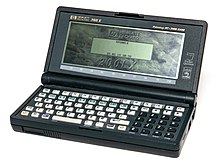|
Palmtop PC
 A Palmtop PC is an obsolete, approximately pocket calculator-sized, battery-powered computer in a horizontal clamshell design with integrated keyboard and display. It could be used like a modern subnotebook, but was light enough to be comfortably used handheld as well. Most Palmtop PCs were small enough to be stored in a user's shirt or jacket pockets. Palmtop PCs distinguish from other palmtop computers by using a mostly IBM-compatible PC architecture, and BIOS as well as an Intel-compatible x86 processor. All such devices were DOS-based, with DOS stored in ROM. While many Palmtop PCs came with a number of PDA and office applications pre-installed in ROM, most of them could also run generic, off-the-shelf PC software with no or little modifications. Some could also run other operating systems such as GEOS, Windows 1.0-3.0 (in Real mode only), or MINIX 2.0. Most Palmtop PCs have been based on a static hardware design for low power consumption, and instant-on/off without the need to reboot. Depending on the model, the battery could power the device for a period ranging from several hours up to several days while running, or between a week and a year in standby mode. Combined with the instant-on/off feature, a battery would typically last from a week up to several months in practical use as PDA. The first Palmtop PC was the DIP Pocket PC (aka Atari Portfolio) in 1989.[1] Palmtop PCs include:
Some touch-screen computers may also be included in this category:
See also
References
|